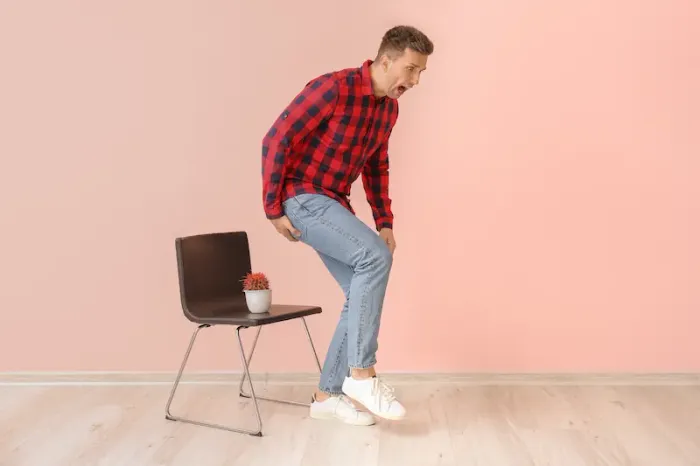Best Exercises to Relieve Anal Fissure Pain
Discover gentle exercises for fissure relief. Ease pain, reduce constipation, and support fissure recovery with safe moves and tips.


Introduction
Anal fissures are small tears in the lining of the anus that can cause sharp pain, bleeding, and muscle spasm during and after bowel movements. While medical care, stool softening, and good bowel habits are the mainstays of treatment, the right movement can help ease discomfort and support healing. This guide covers the best exercises for fissure pain relief, how to move safely, and how to build a simple routine that supports fissure recovery.
According to major medical sources, most fissures improve with conservative care such as fiber, hydration, sitz baths, and topical medications. Gentle activity can complement those steps by helping reduce constipation, lowering muscle tension, and supporting overall well-being. If your pain is severe, bleeding is heavy, or symptoms persist, see a clinician for personalised care.
What is an Anal Fissure?
An anal fissure is a small cut in the skin lining the anus. It often results from passing hard stools or straining with constipation. Typical symptoms include sharp pain with bowel movements, small amounts of bright red blood on toilet tissue, and a spasm-like pain or tightness afterwards. Medical treatments may include fibre, stool softeners, sitz baths, topical anaesthetics, nitroglycerin or calcium channel blocker creams to relax the sphincter muscle, and, for chronic cases, other options your clinician may discuss.
How Exercise Helps Fissure Recovery?
Gentle movement cannot replace medical treatment, but it can support healing in several ways including:
• Helps reduce constipation risk: Regular, low-intensity activity like walking can stimulate bowel function and help maintain regularity, which reduces straining—a key trigger for fissures.
• Encourages pelvic floor relaxation: Calm, diaphragmatic breathing and relaxation techniques can ease anal sphincter spasm, a common source of fissure pain.
• Supports circulation and stress relief: Light activity promotes overall blood flow and can lower stress, which may reduce muscle tension and the perception of pain.
• Builds routine without straining: Short, frequent sessions spread across the week align with widely recommended physical activity guidelines and can be adapted to your comfort.
Safety First: When to Pause and Seek Care
Before starting or changing your routine, especially if pain is intense, talk with your healthcare provider. Stop and seek medical advice if you notice:
• Severe or worsening pain, heavy bleeding, fever, or drainage
• Inability to pass stool or gas
• Pain that does not improve after several weeks of conservative care
• Recent surgery, pregnancy or postpartum concerns, or other conditions affecting bowel or pelvic floor health that warrant tailored guidanceConsult Top Specialists
Best Gentle Exercises for Fissure Pain Relief
The goal is to move in ways that reduce straining and relax the pelvic floor, not to “work” the area. If any movement increases pain or pressure in the anal area, stop and modify. Here are some gentle exercises for fissure pain relief:
1. Comfortable Walking
• Why it helps: Low-impact walking supports bowel regularity and overall circulation without straining.
• How to do it: Start with 10–15 minutes at a comfortable pace once or twice a day. You can break activity into short bouts (for example, 5–10 minutes after meals). Gradually increase time as tolerated.
• Tips: Maintain an easy, conversational pace. Avoid hills or brisk paces if they increase pressure or discomfort.
2. Diaphragmatic (Belly) Breathing
• Why it helps: Deep, slow breathing engages the diaphragm and can trigger whole-body relaxation, helping to reduce pelvic floor and anal sphincter tension that often worsens fissure pain.
• How to do it:
o Lie on your back with knees bent, or sit tall in a chair with back supported.
o Place one hand on your chest and the other on your belly.
o Inhale gently through your nose, letting your belly rise more than your chest.
o Exhale slowly through pursed lips, feeling your belly fall. Avoid bearing down.
o Aim for 5–10 minutes, 1–2 times daily, and especially before bowel movements to reduce guarding and tension.
3. Pelvic Floor Relaxation (“Drop and Breathe” Technique)
• Why it helps: Many people unconsciously tighten the pelvic floor when they anticipate pain. Gentle relaxation can counter this pattern.
• How to do it:
o Sit or lie comfortably. Take a slow belly breath in.
o As you exhale, imagine the anus, perineum, and pelvic floor softening, like lowering an elevator one floor. Think “let go,” not “push down.”
o Repeat 6–8 breaths, 2–3 sets daily, especially before and after bowel movements.
o Important: Avoid doing Kegels (squeezing/strengthening exercises) unless your clinician specifically recommends them. Kegels increase muscle tone and may worsen spasm for some people with fissures.
4. Gentle Yoga Poses to Reduce Tension
Move in and out of each pose slowly. Use pillows or blankets for support. Hold each for 30–60 seconds, breathe calmly, and stop if you feel any pressure, pain, or urge to strain.
• Supported child’s pose: Kneel with big toes touching, knees apart, and rest your chest and belly on stacked pillows. Let your hips sink back comfortably.
• Reclined bound angle pose: Lie on your back, bring the soles of your feet together, and place pillows under your knees for support so the stretch is soft and painless.
• Happy baby (very gentle): On your back, bring knees toward your chest, hold behind your thighs or shins, and softly rock. Keep hips and pelvic floor relaxed; avoid pulling hard.
• Low lunge (supported): From a kneeling position, step one foot forward and place hands on your front thigh or on blocks. Keep the stretch mild through the front of the hip.
5. Hip, Back, and Hamstring Stretches
Easing tension in surrounding muscles can reduce guarding around the pelvic floor.
• Supine hamstring stretch: Lie on your back, loop a towel around one foot, and gently straighten the knee to a light stretch.
• Figure-four stretch: Lying on your back, cross one ankle over the opposite knee and gently pull the uncrossed thigh toward you.
• Cat-cow (gentle): On hands and knees, alternate between arching and rounding your back in a small, comfortable range.
6. Gentle Core Engagement Without Bracing
Avoid heavy bracing or breath-holding. Try:
• Heel slides: Lying on your back with knees bent, slide one heel away and back while keeping breath soft and belly relaxed.
• Marches: While lying on your back, alternate lifting feet a few inches, exhaling gently with each lift.
Activities to Limit During Fissure Recovery
It is important to limit your exercises during recovery. Here are some exercises to limit during this time:
• Heavy lifting and breath holding: High loads and the Valsalva maneuver (holding your breath to brace) raise pressure and can provoke pain and bleeding.
• High-intensity, high-impact workouts that increase anal pressure or pain: Sprinting, box jumps, or heavy core circuits may aggravate symptoms.
• Prolonged cycling on a hard saddle: Pressure on the perineum can irritate symptoms. If you cycle, use a well-padded seat, proper bike fit, or consider a temporary switch to walking.
• Deep or loaded squats and maximal core bracing: Increase only when fully pain-free and cleared by a clinician.
• Kegels without guidance: Strengthening squeezes may worsen sphincter spasm for some people with fissures. Prioritise relaxation unless a healthcare professional advises otherwise.
A Simple, Gentle Daily Routine (15–25 Minutes)
Here’s a simple daily routine:
• 2–3 minutes of diaphragmatic breathing
• 2 minutes of pelvic floor “drop and breathe”
• 5–8 minutes of gentle yoga and stretches (child’s pose, reclined bound angle, hip and hamstring stretches)
• 10–15 minutes of easy walking
• Optional: a warm sitz bath after your walk or after bowel movements, as recommended by your clinician
Lifestyle Tips That Amplify Exercise Benefits
These evidence-based habits work hand-in-hand with exercises for fissure relief and fissure recovery:
• Soften stools:
o Increase dietary fiber gradually from foods like fruits, vegetables, beans, and whole grains. Psyllium fiber supplements may help if recommended by your clinician.
o Drink enough water so urine is pale yellow unless your provider advises fluid restriction.
o Ask your clinician about stool softeners or topical medicines if pain is limiting your ability to pass stool.
• Practice good toilet habits:
o Go when you feel the urge; don’t delay.
o Use a small footstool to elevate your knees above your hips; this can reduce straining.
o Breathe out gently; avoid holding your breath or pushing hard.
o Limit time on the toilet (aim for under 5 minutes). Avoid scrolling on your phone, which can keep you seated longer.
• Use sitz baths:
o Warm water soaks for 10–20 minutes, especially after bowel movements, can relax the anal sphincter and ease pain.
• Pace your activity:
o Short, frequent movement sessions are often more comfortable than long workouts.
o Most adults benefit from regular, moderate activity spread through the week; adapt to comfort and your clinician’s guidance.
• Manage stress and sleep:
o Relaxation, adequate rest, and simple breathing practices can reduce pain sensitivity and muscle tension.Consult Top Specialists
Consult Top Specialists

Dr. Swagata Sircar
General Physician/ Internal Medicine Specialist
8 Years • MBBS, MD General Medicine
Kolkata
HealthYou Speciality Clinic & Diagnostics., Kolkata

Dr. Harshendra Jaiswal
General Physician/ Internal Medicine Specialist
12 Years • MBBS , MD (General medicine)
Kolkata
108 DHANA DHANVANTARI Clinic, Kolkata
(25+ Patients)

Dr. Gunashree V L
General Physician/ Internal Medicine Specialist
3 Years • MBBS
Bengaluru
Apollo Clinic, JP nagar, Bengaluru

Dr. Anand Ravi
General Physician
2 Years • MBBS
Bengaluru
PRESTIGE SHANTHINIKETAN - SOCIETY CLINIC, Bengaluru

Dr. Zulkarnain
General Physician
2 Years • MBBS, PGDM, FFM
Bengaluru
PRESTIGE SHANTHINIKETAN - SOCIETY CLINIC, Bengaluru
Consult Top Specialists

Dr. Swagata Sircar
General Physician/ Internal Medicine Specialist
8 Years • MBBS, MD General Medicine
Kolkata
HealthYou Speciality Clinic & Diagnostics., Kolkata

Dr. Harshendra Jaiswal
General Physician/ Internal Medicine Specialist
12 Years • MBBS , MD (General medicine)
Kolkata
108 DHANA DHANVANTARI Clinic, Kolkata
(25+ Patients)

Dr. Gunashree V L
General Physician/ Internal Medicine Specialist
3 Years • MBBS
Bengaluru
Apollo Clinic, JP nagar, Bengaluru

Dr. Anand Ravi
General Physician
2 Years • MBBS
Bengaluru
PRESTIGE SHANTHINIKETAN - SOCIETY CLINIC, Bengaluru

Dr. Zulkarnain
General Physician
2 Years • MBBS, PGDM, FFM
Bengaluru
PRESTIGE SHANTHINIKETAN - SOCIETY CLINIC, Bengaluru
More articles from Anal fissure
Frequently Asked Questions
1) Can exercise heal an anal fissure?
Exercise alone does not heal a fissure. The foundation of treatment is softening stools, avoiding straining, using sitz baths, and, when needed, medications your clinician prescribes. Gentle activity supports these steps by helping bowel regularity, reducing tension, and improving overall well being.
2) Are Kegels good or bad for fissures?
Kegels strengthen pelvic floor muscles. For some people with fissure related sphincter spasm, repeated squeezing can worsen pain. Focus on relaxation (diaphragmatic breathing and “drop and breathe”) unless a healthcare professional or pelvic floor therapist specifically recommends Kegels for you.
3) Is it safe to walk or run with a fissure?
Walking is usually well tolerated and can help with regularity. Running is fine if it does not increase pain or bleeding, but many people prefer to resume it gradually after pain improves. If running causes symptoms, scale back to walking and rebuild slowly.
4) Will cycling make a fissure worse?
Some people find that pressure from the saddle aggravates symptoms. If cycling increases pain, try a more cushioned seat, adjust your bike fit, wear padded shorts, or take a break and switch to walking until you are comfortable again.
5) How long does it take to recover, and when should I see a doctor?
Many acute fissures improve within several weeks with conservative care. If your symptoms last beyond a few weeks, are severe, or you have recurrent fissures, see a clinician. Treatments such as prescription ointments or other interventions may be needed.

